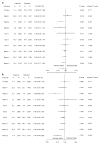Combined intensive blood pressure and glycemic control does not produce an additive benefit on microvascular outcomes in type 2 diabetic patients
- PMID: 22166848
- PMCID: PMC4641306
- DOI: 10.1038/ki.2011.415
Combined intensive blood pressure and glycemic control does not produce an additive benefit on microvascular outcomes in type 2 diabetic patients
Abstract
A reduction of either blood pressure or glycemia decreases some microvascular complications of type 2 diabetes, and we studied here their combined effects. In total, 4733 older adults with established type 2 diabetes and hypertension were randomly assigned to intensive (systolic blood pressure less than 120 mm Hg) or standard (systolic blood pressure less than 140 mm Hg) blood pressure control, and separately to intensive (HbA1c less than 0.060) or standard (HbA1c 0.070-0.079) glycemic control. Prespecified microvascular outcomes were a composite of renal failure and retinopathy and nine single outcomes. Proportional hazard regression models were used without correction for type I error due to multiple tests. During a mean follow-up of 4.7 years, the primary outcome occurred in 11.4% of intensive and 10.9% of standard blood pressure patients (hazard ratio 1.08), and in 11.1% of intensive and 11.2% of standard glycemia control patients. Intensive blood pressure control only reduced the incidence of microalbuminuria (hazard ratio 0.84), and intensive glycemic control reduced the incidence of macroalbuminuria and a few other microvascular outcomes. There was no interaction between blood pressure and glycemic control, and neither treatment prevented renal failure. Thus, in older patients with established type 2 diabetes and hypertension, intensive blood pressure control improved only 1 of 10 prespecified microvascular outcomes. None of the outcomes were significantly reduced by simultaneous intensive treatment of glycemia and blood pressure, signifying the lack of an additional beneficial effect from combined treatment.
Figures


Comment in
-
ACP Journal Club. Intensive BP control and/or glucose control did not reduce microvascular events in hypertensive type 2 diabetes.Ann Intern Med. 2012 Oct 16;157(8):JC4-7. doi: 10.7326/0003-4819-157-8-201210160-02007. Ann Intern Med. 2012. PMID: 23070509 No abstract available.
References
-
- UK Prospective Diabetes Study (UKPDS) Group. Intensive blood-glucose control with sulphonyl ureas or insulin compared with conventional treatment and risk of complications in patients with type 2 diabetes (UKPDS 33) Lancet. 1998;352:837–853. - PubMed
-
- UK Prospective Diabetes Study (UKPDS) Group. Effect of intensive bloodglucose control with metformin on complications in overweight patients with type 2 diabetes (UKPDS 34) Lancet. 1998;352:854–865. - PubMed
-
- Patel A, MacMahon S, Chalmers J, et al. Intensive blood glucose control and vascular outcomes in patients with type 2 diabetes. N Engl J Med. 2008;358:2560–2572. - PubMed
-
- Duckworth WC, Abraira C, Moritz TE, et al. Glucose control and vascular complications in veterans with type 2 diabetes. N Engl J Med. 2009;360:129–139. Correction: N Engl J Med 2009; 361:1024–1025. - PubMed
Publication types
MeSH terms
Substances
Grants and funding
- N01 HC095179/HL/NHLBI NIH HHS/United States
- N01 HC095184/HL/NHLBI NIH HHS/United States
- N01-HC-95180/HC/NHLBI NIH HHS/United States
- N01 HC095178/HL/NHLBI NIH HHS/United States
- N01-HC-95184/HC/NHLBI NIH HHS/United States
- IAA-Y1-HC-1010/HC/NHLBI NIH HHS/United States
- N01 HC095182/HL/NHLBI NIH HHS/United States
- N01-HC-95183/HC/NHLBI NIH HHS/United States
- P30 DK092924/DK/NIDDK NIH HHS/United States
- N01-HC-95178/HC/NHLBI NIH HHS/United States
- N01-HC-95179/HC/NHLBI NIH HHS/United States
- N01-HC-95181/HC/NHLBI NIH HHS/United States
- IAA-Y1-HC-9035/HC/NHLBI NIH HHS/United States
- N01 HC095180/HL/NHLBI NIH HHS/United States
- Y01 HC001010/HC/NHLBI NIH HHS/United States
- Y01 HC009035/HC/NHLBI NIH HHS/United States
- N01 HC095181/HL/NHLBI NIH HHS/United States
- N01-HC-95182/HC/NHLBI NIH HHS/United States
- N01 HC095183/HL/NHLBI NIH HHS/United States
LinkOut - more resources
Full Text Sources
Medical

